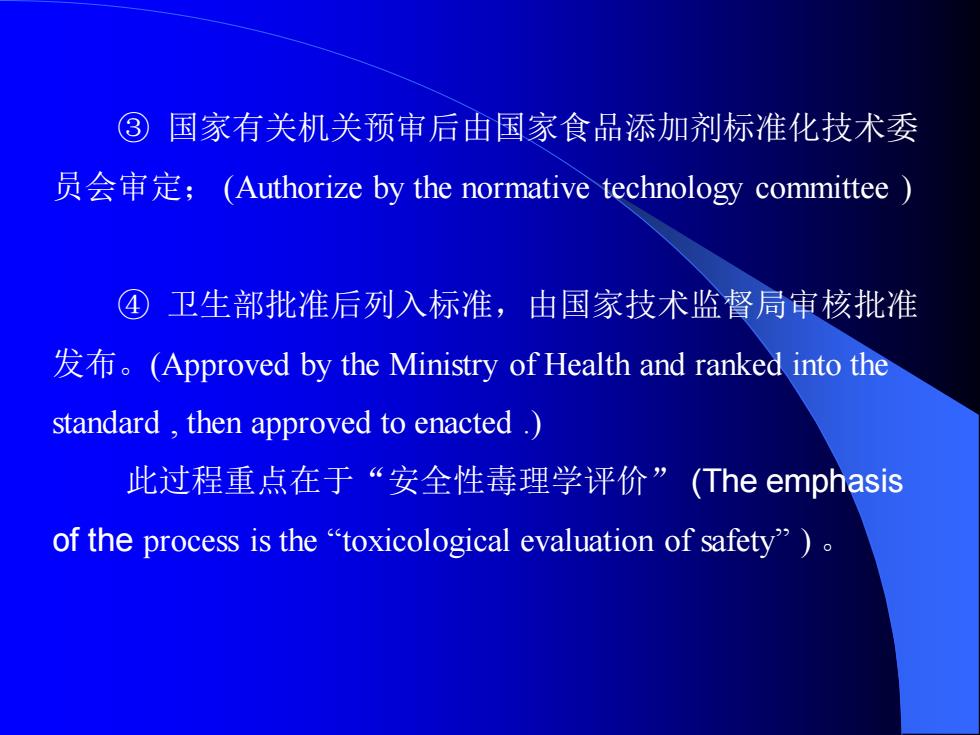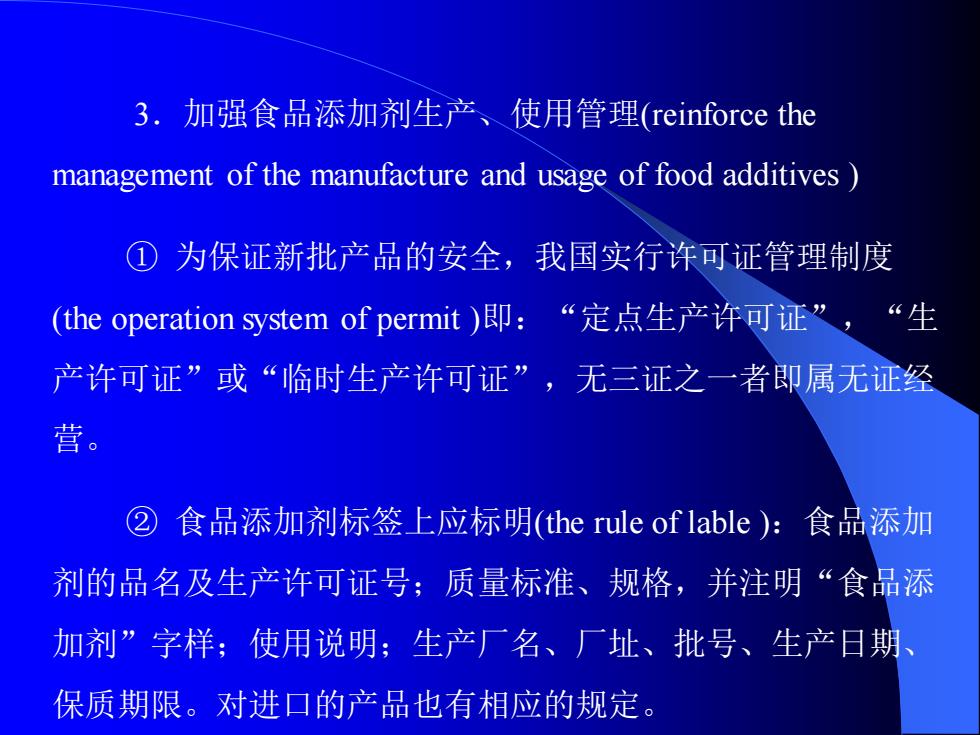
二、食品添加剂的卫生管理 the management of food additives in our country (一)我国对食品添加剂的管理(setting up and enforcing the regulation and health standard of food additives) 1.制定和执行《食品添加剂使用卫生标准》和法规 我国在20世纪70年代初至80年代初:大量基础工作,制定 《各类食品添加剂的管理办法》,使之列入国家标准(GB), 包括:种类、名称、使用范围、最大使用量等。 我国的食品卫生法从1982年的试行到1995年颁布的《中华 人民共和国食品卫生法》有10条对食品添加剂有法律规定。如11 条中规定:生产经营和使用食品添加剂,必须符合食品添加剂 使用卫生标准和管理办法的规定,不符合卫生标准和卫生管理 办法的食品添加剂,不得经营、使用
二、食品添加剂的卫生管理 the management of food additives in our country (一)我国对食品添加剂的管理(setting up and enforcing the regulation and health standard of food additives) 1.制定和执行《食品添加剂使用卫生标准》和法规 我国在20世纪70年代初至80年代初:大量基础工作,制定 《各类食品添加剂的管理办法》,使之列入国家标准(GB), 包括:种类、名称、使用范围、最大使用量等。 我国的食品卫生法从1982年的试行到1995年颁布的《中华 人民共和国食品卫生法》有10条对食品添加剂有法律规定。如11 条中规定:生产经营和使用食品添加剂,必须符合食品添加剂 使用卫生标准和管理办法的规定,不符合卫生标准和卫生管理 办法的食品添加剂,不得经营、使用

2.颁布和执行新食品添加剂审批程序,未列入标准的, 要严格按照审批程序,经批准后方能生产使用。(enacting /promulgate and enforcing the examination process of new food additives ) ① 由申请者向省一级食品卫生监督机构提出申请并提供 各种资料(put the application with the information needed forward to the food health supervisal organization )(名称、性质、工艺、 质量标准、毒性试验、使用范围、效果、用量、残留、检验方 法等国内外资料); ② 初审(由省一级食品卫生监督机构组织专家评审); (the primary examination )
2.颁布和执行新食品添加剂审批程序,未列入标准的, 要严格按照审批程序,经批准后方能生产使用。(enacting /promulgate and enforcing the examination process of new food additives ) ① 由申请者向省一级食品卫生监督机构提出申请并提供 各种资料(put the application with the information needed forward to the food health supervisal organization )(名称、性质、工艺、 质量标准、毒性试验、使用范围、效果、用量、残留、检验方 法等国内外资料); ② 初审(由省一级食品卫生监督机构组织专家评审); (the primary examination )

③ 国家有关机关预审后由国家食品添加剂标准化技术委 员会审定; (Authorize by the normative technology committee ) ④ 卫生部批准后列入标准,由国家技术监督局审核批准 发布。(Approved by the Ministry of Health and ranked into the standard , then approved to enacted .) 此过程重点在于“安全性毒理学评价” (The emphasis of the process is the “toxicological evaluation of safety” )
③ 国家有关机关预审后由国家食品添加剂标准化技术委 员会审定; (Authorize by the normative technology committee ) ④ 卫生部批准后列入标准,由国家技术监督局审核批准 发布。(Approved by the Ministry of Health and ranked into the standard , then approved to enacted .) 此过程重点在于“安全性毒理学评价” (The emphasis of the process is the “toxicological evaluation of safety” )

3.加强食品添加剂生产、使用管理(reinforce the management of the manufacture and usage of food additives ) ① 为保证新批产品的安全,我国实行许可证管理制度 (the operation system of permit )即:“定点生产许可证” , “生 产许可证”或“临时生产许可证”,无三证之一者即属无证经 营。 ② 食品添加剂标签上应标明(the rule of lable ):食品添加 剂的品名及生产许可证号;质量标准、规格,并注明“食品添 加剂”字样;使用说明;生产厂名、厂址、批号、生产日期、 保质期限。对进口的产品也有相应的规定
3.加强食品添加剂生产、使用管理(reinforce the management of the manufacture and usage of food additives ) ① 为保证新批产品的安全,我国实行许可证管理制度 (the operation system of permit )即:“定点生产许可证” , “生 产许可证”或“临时生产许可证”,无三证之一者即属无证经 营。 ② 食品添加剂标签上应标明(the rule of lable ):食品添加 剂的品名及生产许可证号;质量标准、规格,并注明“食品添 加剂”字样;使用说明;生产厂名、厂址、批号、生产日期、 保质期限。对进口的产品也有相应的规定

(二)联合国FAO/WHO对食品添加剂的卫生管理 the management of food additives of FAO 第一类 一般认为是安全的(generalrecognized as safe,GRAS),不需制定ADI 值,可正常使用。 第二类 A类(A1、A2) A1 毒理学已清楚,可以使用,并定有ADI值。 A2 毒理学资料不够完善,但已暂订有ADI值,暂时允许使用于食品。 第三类 B类,毒理学资料不足,未订有ADI值。 第四类 C类(C1、C2),原则上禁止使用的食品添加剂。 C1 毒理学资料认为不安全者。 C2 严格限制于某些特殊用途的食品。 (三)其他国家对食品添加剂的卫生管理(美、欧、日) FAO/WHO食品添加剂联合专家委员会(Joint FAO/WHO Expert Committee on Food Additives,JECFA)对食品添加剂在 安全评价基础上制定出它们的ADI值,并向各国政府建议。 JECFA建议把食品添加剂分为四类:
(二)联合国FAO/WHO对食品添加剂的卫生管理 the management of food additives of FAO 第一类 一般认为是安全的(generalrecognized as safe,GRAS),不需制定ADI 值,可正常使用。 第二类 A类(A1、A2) A1 毒理学已清楚,可以使用,并定有ADI值。 A2 毒理学资料不够完善,但已暂订有ADI值,暂时允许使用于食品。 第三类 B类,毒理学资料不足,未订有ADI值。 第四类 C类(C1、C2),原则上禁止使用的食品添加剂。 C1 毒理学资料认为不安全者。 C2 严格限制于某些特殊用途的食品。 (三)其他国家对食品添加剂的卫生管理(美、欧、日) FAO/WHO食品添加剂联合专家委员会(Joint FAO/WHO Expert Committee on Food Additives,JECFA)对食品添加剂在 安全评价基础上制定出它们的ADI值,并向各国政府建议。 JECFA建议把食品添加剂分为四类: